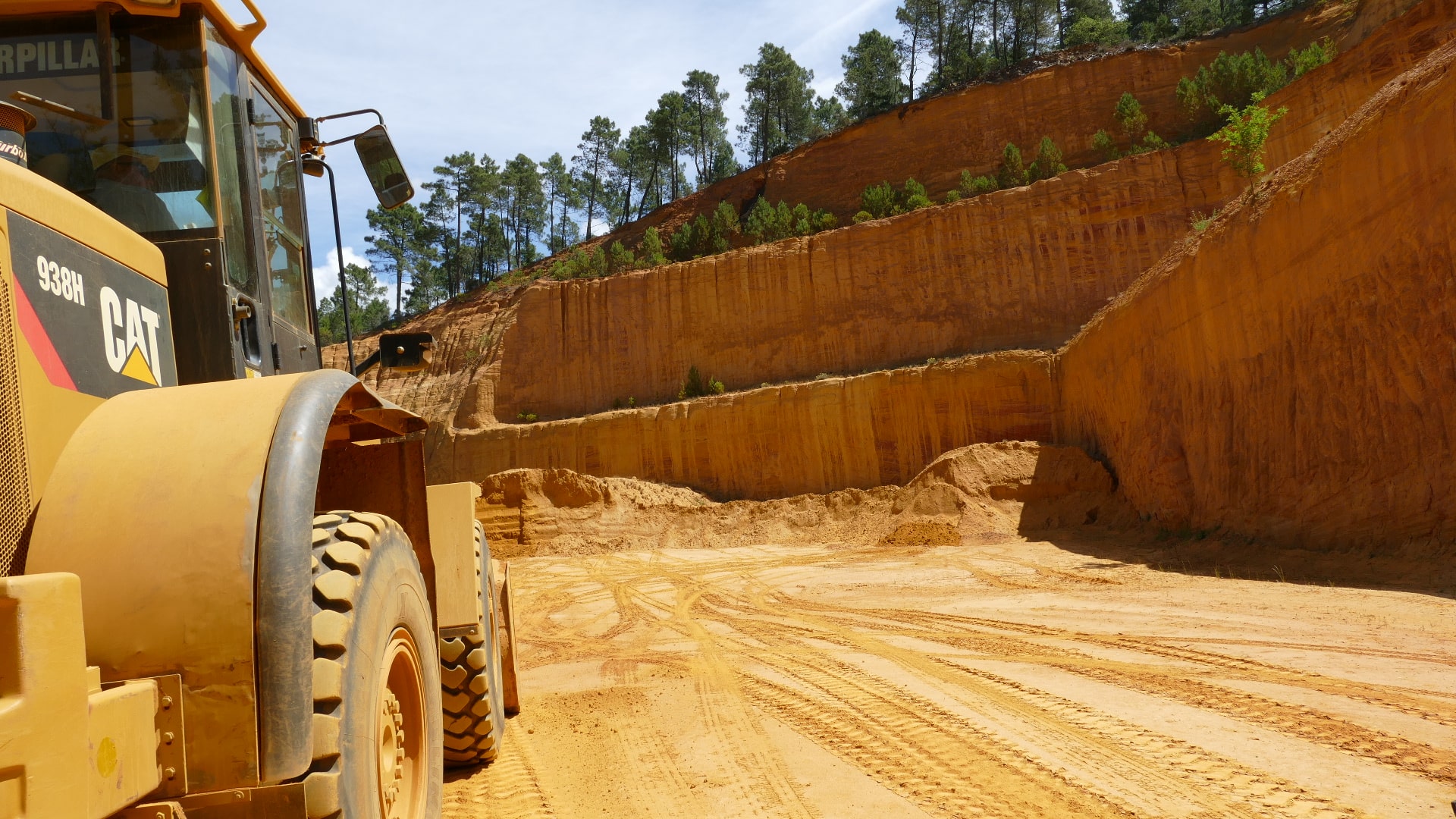The manufacture of ochre
Ochre... What is it ?
Ochre is not a color but a material in its own right. It's a a ferric rock composed of white clay (kaolinite) and iron oxide (hematite) or hydroxide (goethite). In the nature, this coloured clay is amalgamated with sand which represents about 90% of ochre ores. To extract pure ochre, many steps are necessary and followed according to the seasons : extraction, washing, decantation, drying, grinding and possibly calcination to obtain other shades than yellow/orange, majority in our quarry.
How it's made ?
Step 1 : the extraction
Timing : 10 days/per year, at the beginning of september or mid-march
Place : Gargas
The first step is extraction.
Ochre is extracted from ochre ore. In the deposits, the ore is quite compact, which requires the use of a mechanical shovel for winning. The ore consists of about 90% of very fine silica sand and 10% of pure ochre on average.
The first step is to remove with a shovel the unexploitable ore (called “discovery”) that covers the “beautiful” ore. This "discovery" will be set aside for the future redevelopment of the quarry, in accordance with the guidelines of the Ministry of the Environment. Benches of twenty-five meters minimum width and fifteen meters height are made to ensure the facing and to prevent rock falls during the extraction campaigns.
The ore is removed by trucks and transported to the wash area.
Step 2 : the washing
Timing : from september to may
Place : Gargas
Until 1960, the disposal of the sands was done by levitation : a current carried the ore in a "cofferdam". The sand, heavier, settled at the bottom. The remaining ochre suspended in the water was carried by the water into settling ponds of 200 m3. The process was repeated daily until the ponds were full. The output of this process was 200 kg per m3 of ore.
From May, when ochre had taken on a firm consistency, walls made of ochre clods were built around basins, allowing complete drying under the action of the mistral and the sun.
Today, this mode of washing has changed. The "cofferdams" have been removed. Water is thrown at high pressure onto the ochre ore which, in liquid form, is sent through a thickener separator (rubber-coated cyclone to avoid abrasion) by a rubber-protected pump to the cyclone inlet. The mixture comes with a pressure of 0.9 bar. Under the action of the centripetal force, the sand concentrated on the center of the cyclone falls, almost dry, and the ochre comes out in overflow then is directed towards the pipe going to the settling bassins.
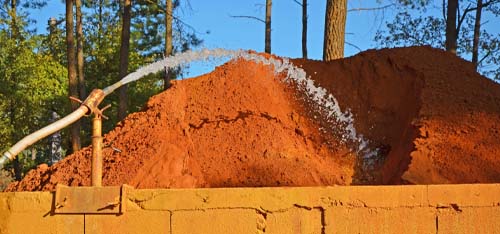
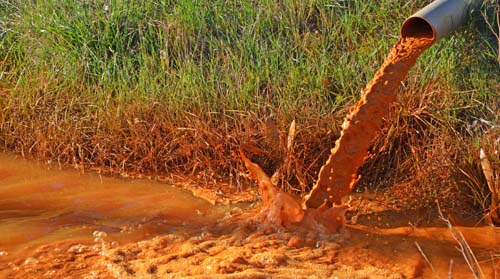
Step 3 : the settling & drying
Time : during the washing for settling, during summer for drying
Place : Gargas
The final phase of ochre washing is settling. The basins are filled with water and ochre which, heavier, settles at the bottom of the pond. By means of a "drain" system, the water is drained. When the basin reaches a thickness of about 30 cm or 200 tonnes per basin, the drying period from July to the end of August can begin. The ochre is then taken out of the basins and dried, thanks to the help of the mistral, on a large platform.
After that, the ochre will be transported to the factory for the completion of its manufacture.
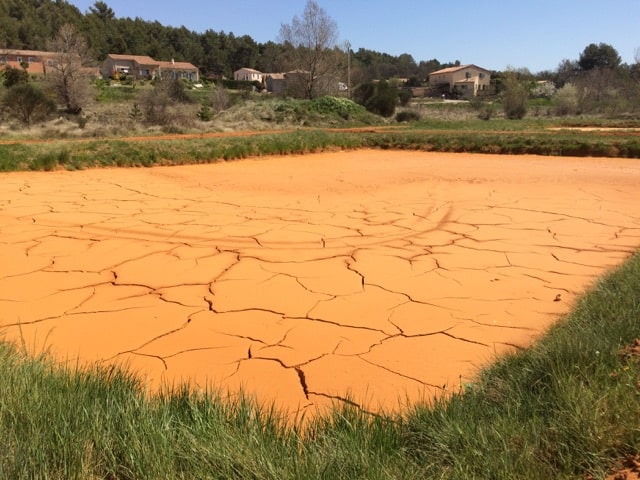
Step 4 : the calcination
Timing : in accordance with commands
Place : Apt
In our career, we mainly have yellow ochre (goethite). By heating the ochre around 900 degrees, the iron hydroxide dehydrates and turns into hematite. The ordinarily yellow colour, becomes red. Calcination of yellow ochres or insufficiently red naturally, was made in time by wood-burning kiln. Now, it is done in rotary furnace, heated with gas. This fugnace have a length of 12 meters and a diameter of 0,80 meter. It is bricked to keep the heat.
The ochre is sent to the head of the kiln and received, on the burner side, at the temperature of about 400 degrees. It takes 15 minutes to cross it. It is, at this moment, baked to perfection. After a few days of cooling, it is ready to be grinded and bagged.
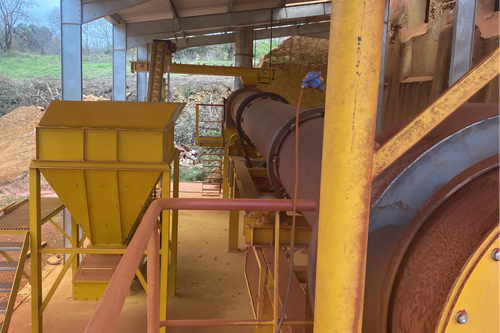
Step 5 : Grinding and packaging
Timing : throughout the year
Place : Apt
To obtain different shades, you can mix different ochres or earths. Then, the whole (or a single pigment) is sent in a pendulum crusher where the ochre is crushed to 80 μ. The packaging is then done in paper bags of 15, 20 or 25 kilos according to the references. For several years, new packaging has enriched the range.
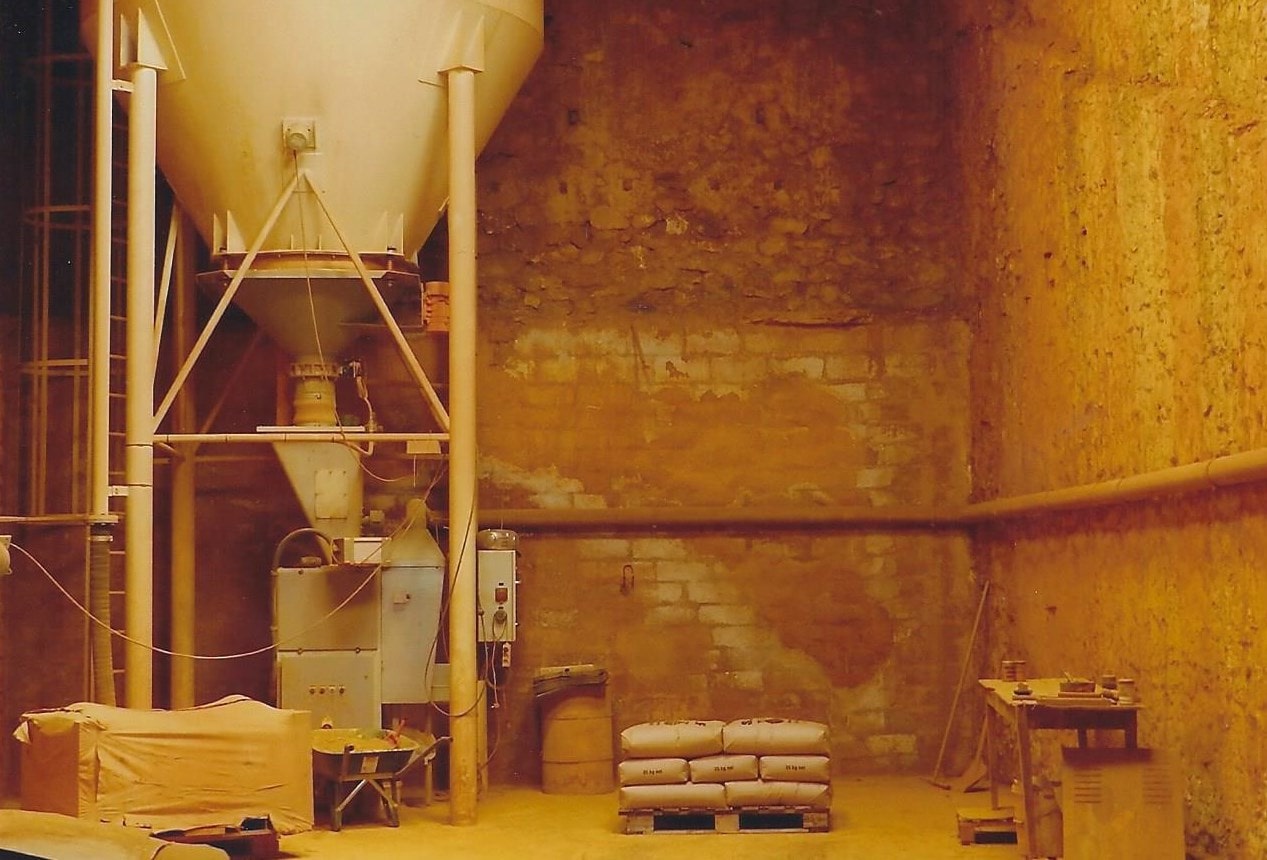
Okay... But what that's for ?
Today, between 800 tons of ochre are extracted per year.
It is used in many applications :
- In the building industry : for colouring coatings, lime paints, concrete...
- In industrial or artistic paintings.
- For the coloring of terracotta, tiles.
- For cosmetics.
- In the ceramic industry.
- In agriculture : for coloring fertilizers.
In short, ochre can color any binder !
This ochre is send all over the world : Africa (mostly), Europa but also USA, Canada, Japan, Australia, New-Zeland, etc.
Ochre residues (coloured sands that are separated from ochre at the time of washing) are recycled and used in earthworks and for the covering of trench cables.
At the peak of production, 40,000 tons of ochre were extracted per year in the Apt area. This high production lasted from the 1880s to the 1940s, golden years of the Apt area's production. In addition to the above mentioned uses, ochre was used in the manufacture of rubber in order to thicken it (example : bottle teats, jars rings, bicycle tubes). Ochre was also used in the manufacture of linoleum.
When ochre ceased to be used in the rubber industry, factories began to close one by one in the 1950s (for more information, you can read "The history of our company"). That is for this reason that nowadays, Ocres de France is the last autonomous company in Europe that exploits and transforms ochre ore into pure ochre.
Where do we find ochre ?
Ochre is a pigment used since Prehistory that is found -in quite different quantities- on the 5 continents. You have surely heard of these magnificent old quarries (the Colorado Provençal, the Sentier des Ocres de Roussillon...) that are no longer exploited since the 1950s but attract thousands of tourists every year. Our area -the Luberon- is considered as the largest ochre deposit in the world and our quarry, located in Gargas, is now the last in operation in Europe.
There is another deposit, in Bourgogne, whose proportions are different : the ochre ore is composed of 20% sand and 80% ochre. A company in Puisaye operates a quarry but for its clay (the "discovery" being ochre).
Does an industry necessarily pollute ? No !
The issue of a licence to open an ochre quarry is subject to a public inquiry and an impact assessment.
The extraction authorization is valid for 15 years and the volume is limited (20 000 tons/per yer of ochre ore for the SOF quarry).
Rehabilitation of the quarry is mandatory at the close of the extraction authorization. In 2010, SOF applied to renewal its licence which has been accepted for the next 30 years, thanks to its good conduct and respect of the environment
The quarry and the factory are regularly inspected by the APAVE and the DIREN because, like all quarries and factories, they are classified ICPE (french Classified Facility for Environmental Protection).
In Gargas, the Société des Ocres de France has a major advantage : it uses, in closed circuit, more than 500 m3 of water per day to wash its ochre. Only 30 m3 are lost by infiltration. The wash water is pumped into old ochre galleries and returned to these galleries after washing. There is no pollution of water by ochre.
With regard to air pollution, a dust control device is installed on the plant chimneys to purify the fumes resulting from the burning of red ochres and dust control measures are taken regularly.
The rainwater is collected in a large basin to avoid that, charged with ochre, it runs off and pours into the Coulon (river).
Packaging is recycled and/or recyclable (even briefcases) and office paper is crushed and reused. The small jars are made of glass (food grade), to be thrown into the glass bins by removing the capsule ; while the 600ml and 1500ml jars are made of P.E.T plastic : this is a completely recyclable plastic which, transformed into flakes, will be used in the manufacture of clothing, upholstery, etc.). The jars are to be thrown into the yellow bins. For the buckets, we use polypropylene, also recyclable, which is used in the automotive, textile industry (also to throw in the yellow bins). Our bags are made of kraft paper, as well as the cushion in the packages. The boxes are made of pallet wood. We use vegetable inks for our colour charts and received paper.
All the ochres produced were subjected to a complete analysis in search of heavy metals and nanoparticles.
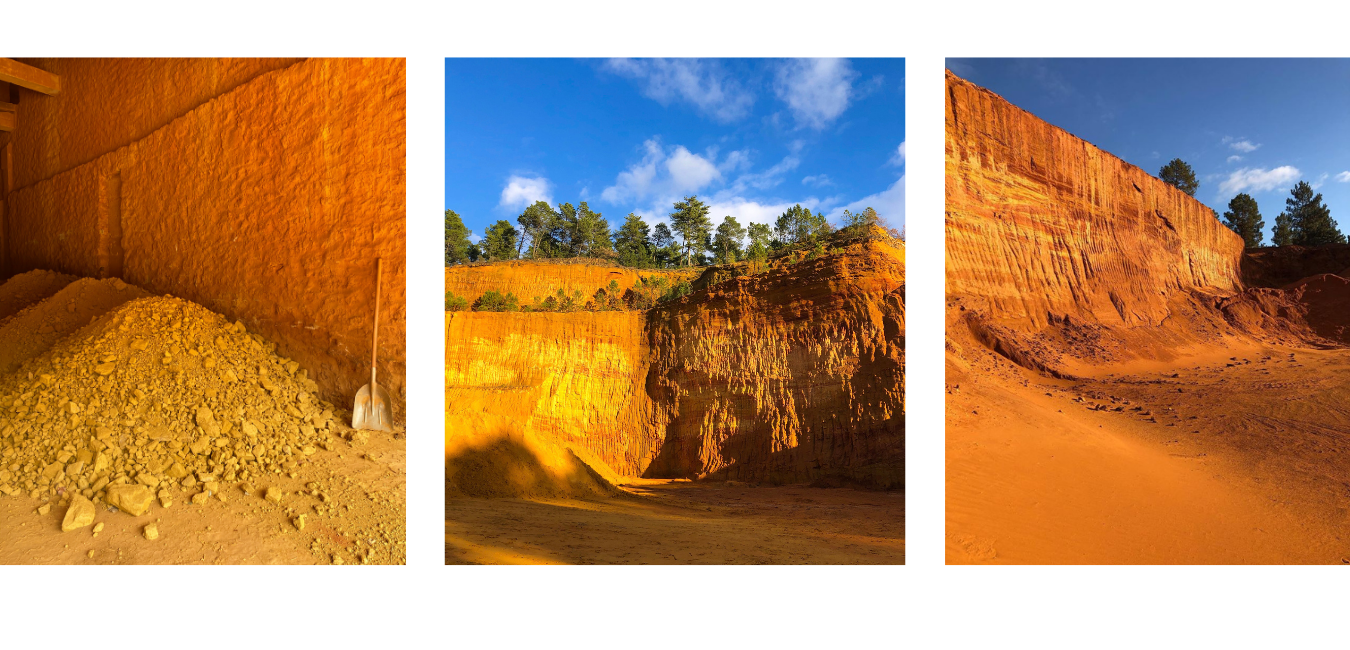
Our commitments
- A human team, responsive and attentive to customer needs
- Availability of commercial service
- After-sales service & rigorous tracking of the delivery of your parcels
- Close collaboration with suppliers, preferred among local manufacturers
- Strict control of raw materials
- Implementation of environmental recommendations.
Have more questions? Write to us at infos@ocres-de-france or on our social networks Facebook & Instagram ! :-)

